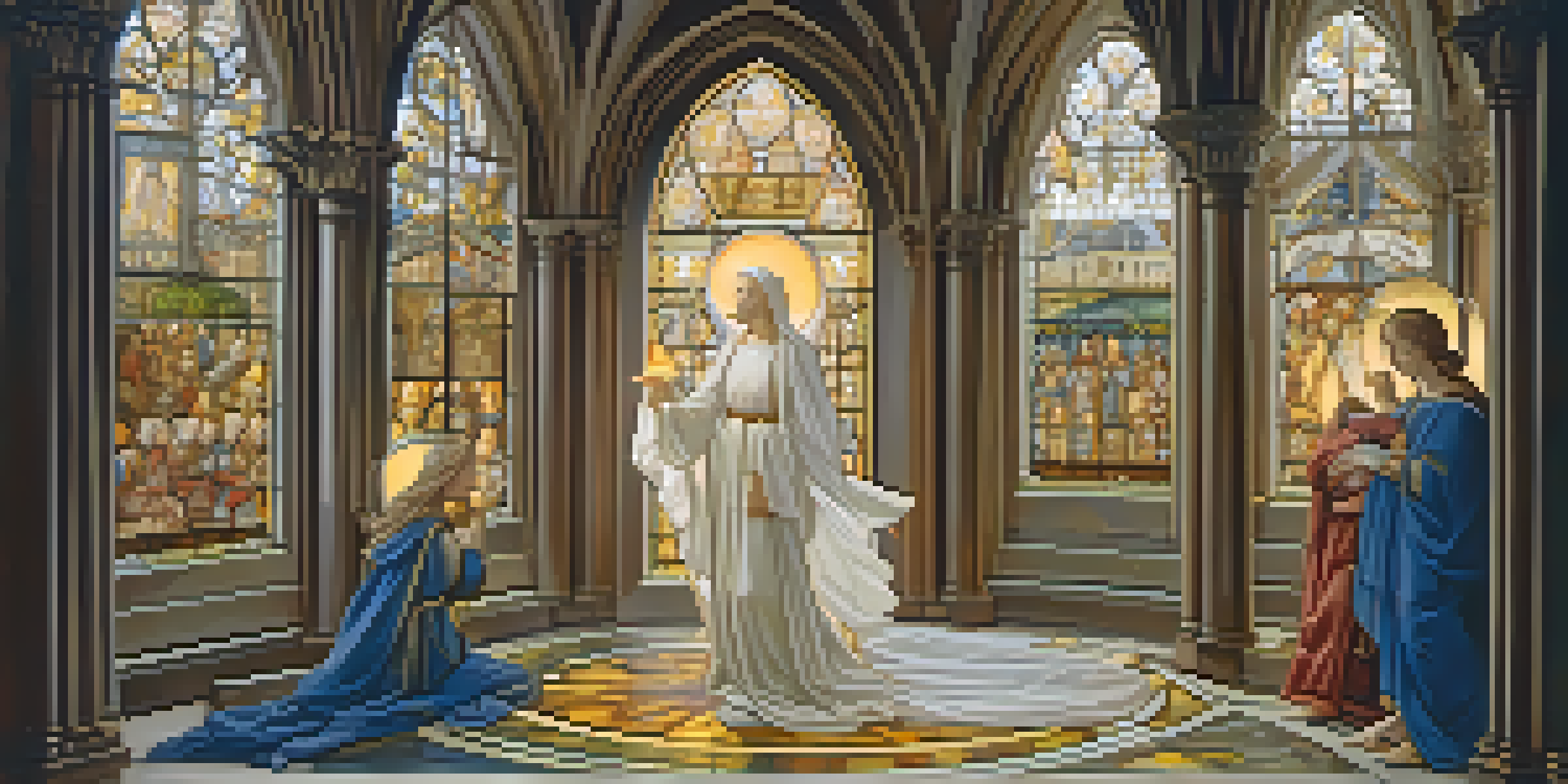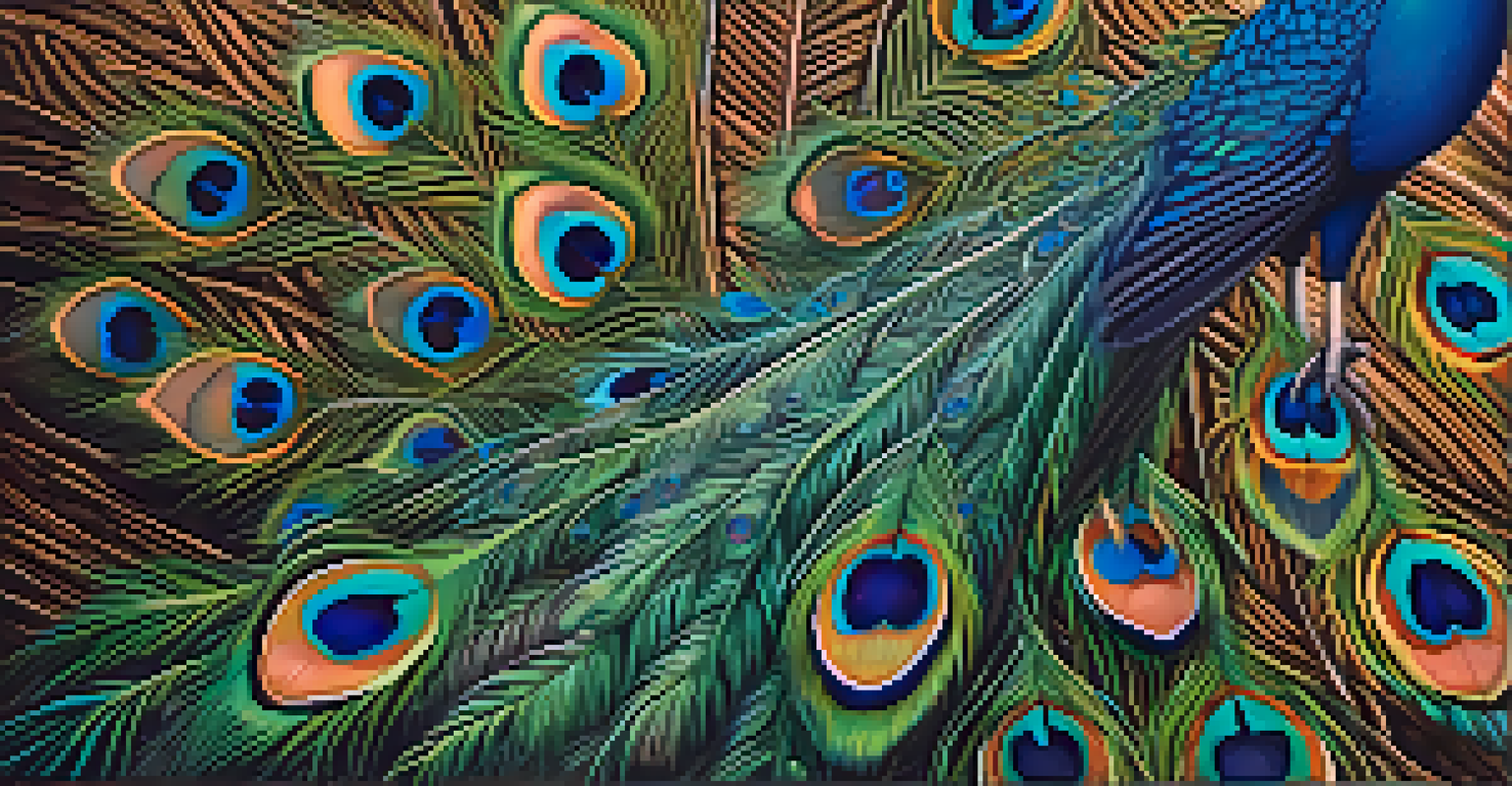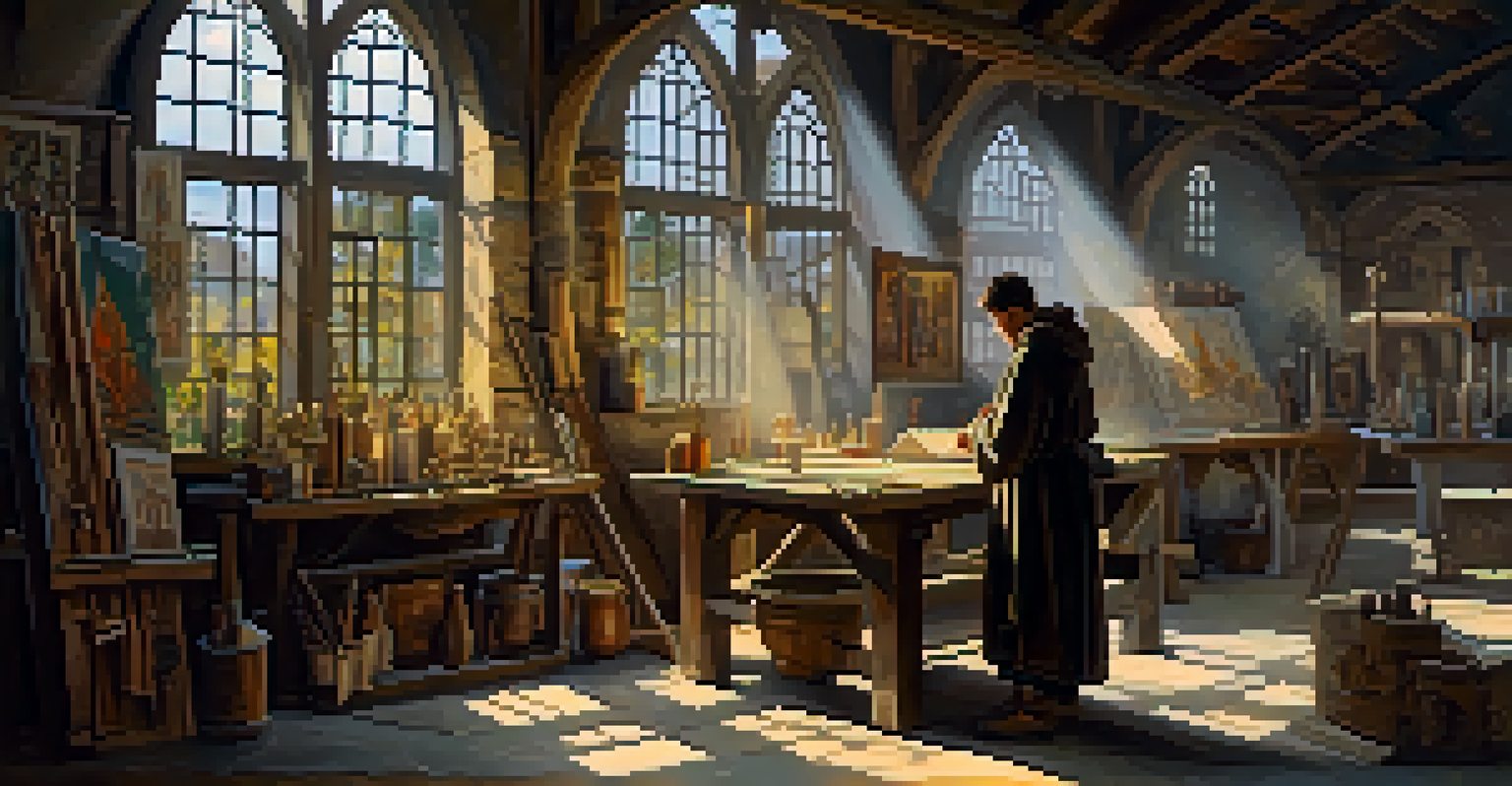Decoding Visual Symbols in Medieval Religious Artworks

Understanding the Role of Symbols in Medieval Art
Medieval religious art is rich with symbolism, where every detail often carries profound meaning. Artists used visual symbols to convey complex theological concepts that were not easily expressed through words. For instance, a simple lamb can represent Christ, reflecting purity and sacrifice, which resonates deeply with viewers. This symbolic language was crucial for educating a largely illiterate populace about spiritual truths.
Art is the most beautiful of all lies.
In an age when many people could not read, the visual elements of artworks became a form of storytelling. Each symbol acted as a visual cue, guiding the viewer's understanding and connection to the divine. The use of color, position, and even the expressions of figures were all meticulously planned to convey specific messages. Thus, deciphering these symbols opens up a richer appreciation of the artwork's spiritual context.
As we delve into specific symbols, we uncover layers of meaning that reveal the beliefs and practices of the medieval period. This exploration not only enhances our understanding of the artworks themselves but also sheds light on the culture and society of the time. By recognizing these symbols, we can appreciate how medieval artists communicated complex ideas through their creations.
Common Symbols and Their Meanings
Several symbols commonly appear in medieval religious art, each with its own distinct significance. For example, the use of the cross is ubiquitous, symbolizing Christ's sacrifice and the promise of salvation. Similarly, the image of a peacock often represents immortality, highlighting the belief in eternal life that was central to medieval Christianity. Understanding these symbols is essential for grasping the spiritual messages embedded within the art.

Another frequently encountered symbol is the halo, which signifies holiness and divine favor. Figures depicted with halos are often saints or Christ himself, indicating their revered status. The colors and designs of halos can also convey additional meanings; for instance, a golden halo often represents divine light. This intricate system of symbols allows viewers to interpret the moral and theological lessons intended by the artists.
Symbols Convey Deep Spiritual Meanings
Medieval art utilized visual symbols to express complex theological concepts, aiding a largely illiterate audience in understanding spiritual truths.
Moreover, animals in medieval art are not just depicted for their aesthetic qualities; they often carry deep symbolic meanings. A dove, for example, can symbolize the Holy Spirit, while a serpent may represent sin or the devil. By recognizing these symbols, we can gain insight into the moral and spiritual lessons the artists sought to impart to their audience.
The Influence of Biblical Narratives on Art
Biblical stories served as a primary source of inspiration for medieval artists, shaping the symbols they employed. Artists often illustrated scenes from the Old and New Testaments, using familiar narratives to convey religious teachings. This not only helped viewers connect with the stories but also reinforced their beliefs. For instance, the Annunciation scene depicts the angel Gabriel delivering the news to Mary, often accompanied by symbols like lilies representing purity.
Symbols are the language of the soul.
The choice of narratives was significant, as they often highlighted key moments of faith and divine intervention. By visually interpreting these stories, artists created a bridge between the sacred texts and the viewers' everyday lives. The symbolism present in these artworks allowed for a deeper reflection on the narratives, encouraging viewers to contemplate their own faith and morals.
As we explore specific artworks, we can see how these biblical stories were transformed into visual symbols. For example, in a depiction of the Last Supper, the arrangement of figures and the use of light can emphasize themes of betrayal and redemption. These symbols not only enrich the artwork but also invite viewers to engage with the spiritual lessons embedded within these timeless narratives.
Regional Variations in Symbolism
While many symbols are universally recognized, regional variations also play a significant role in medieval art. Different cultures and traditions infused their unique interpretations into common symbols. For instance, while the lamb is a symbol of Christ in many regions, in some cultures, it may also represent innocence or purity in a broader sense. This diversity enriches the understanding of these symbols and their meanings.
Furthermore, local customs often influenced the way symbols were depicted in artworks. In Italy, for example, artists might highlight the Virgin Mary with specific colors that resonate with local traditions, such as blue representing her purity. In contrast, Northern European artists might focus on different aspects, such as the natural landscape surrounding religious figures, to convey a sense of place and context.
Biblical Narratives Inspire Art
Artists drew inspiration from biblical stories, using familiar narratives as a foundation to convey religious teachings through symbolism.
Exploring these regional differences allows us to appreciate how local culture shaped artistic expression. It provides a lens through which we can examine the interconnectedness of art, faith, and community during the medieval period. By recognizing these variations, we can better understand the rich tapestry of medieval religious art and its enduring impact.
The Evolution of Symbolism Over Time
As the medieval period progressed, the use of symbolism in religious art also evolved. Early artworks were often more straightforward in their symbolism, focusing on clear representations of biblical stories and figures. However, as artists gained more freedom, they began to experiment with more complex and nuanced symbols. This evolution reflects broader changes in theological thought and the relationship between art and religion during the period.
During the Gothic period, for instance, artists began to incorporate more intricate designs and layered meanings. The use of light and shadow became more pronounced, enhancing the emotional and spiritual depth of the symbols. This shift allowed for a more profound connection between the viewer and the artwork, as symbols became more than mere representations; they evolved into vehicles of contemplation and reflection.
By studying this evolution, we can gain insights into the changing attitudes toward spirituality and art over the centuries. As artists sought to engage viewers on a deeper level, the symbols they employed became richer and more multifaceted. This journey through time highlights the dynamic interplay between faith, culture, and artistic expression in medieval society.
The Role of Iconography in Interpretation
Iconography, the study of symbols and their meanings, plays a crucial role in interpreting medieval religious artworks. Understanding the specific symbols used in a piece allows viewers to unlock the deeper messages intended by the artist. This analytical approach goes beyond mere aesthetic appreciation, inviting us to engage with the artwork on a more intellectual level. For example, recognizing the significance of a particular saint in a painting can illuminate the moral lesson being conveyed.
Moreover, iconography helps to contextualize artworks within their historical and cultural framework. By examining the symbols and their meanings, we can better understand the beliefs and values of the society that produced them. This context enriches our appreciation of the artwork and allows us to see how it reflects the complexities of medieval life.
Iconography Enhances Art Interpretation
The study of iconography allows viewers to decode the deeper messages in medieval artworks, revealing the cultural and historical context behind the symbols.
Through iconography, we also discover connections between different artworks and traditions. Many symbols were reused and adapted across various regions and periods, creating a shared language of faith and art. By exploring these connections, we can develop a more comprehensive understanding of medieval religious art and its enduring legacy.
Conclusion: The Lasting Impact of Symbolism
The symbolism found in medieval religious artworks continues to resonate today, inviting us to reflect on our beliefs and values. By decoding these visual symbols, we can appreciate not only the artistry but also the profound spiritual messages they convey. This exploration allows us to connect with the past, understanding how art served as a bridge between the divine and the earthly realm.
As we engage with these symbols, we also recognize their continued relevance in contemporary discussions around faith and spirituality. The themes of sacrifice, redemption, and hope depicted in medieval art are timeless, reminding us of the universal human experience. In a world that often feels disconnected, these symbols can serve as a reminder of our shared values and beliefs.

Ultimately, the study of symbolism in medieval religious art enriches our understanding of both the artworks themselves and the broader cultural landscape of the time. By continuing to explore these visual narratives, we honor the legacy of the artists who used their talents to communicate profound truths, inviting us to consider our own journey of faith and understanding.